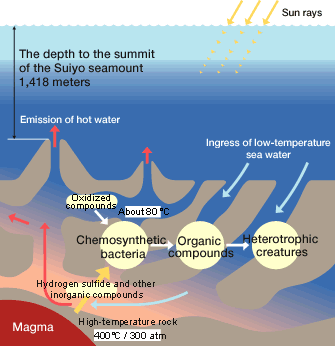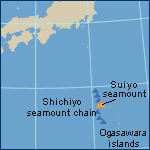| Research: Index > Primitive life forms and the form of the earth |
| The time of environment Primitive life forms and the form of the earth | |
| |
| The earth was born about 4.6 billion years ago in a magma state. Heat was emitted into space, primitive oceans were formed, and organic compounds accumulated in it over a long period of time. Likely, the first organisms were heterotrophic creatures created in the soup of these organic compounds. Then, before the limited amount of organic compounds could be consumed completely, living creatures using the energy from inorganic compounds to create organic material were born. These are called chemotrophs. These chemotrophs still exist today near the hydrothermal vents on the sea bottom, which produce a continual supply of hydrogen sulfide and other inorganic compounds. Research into the chromosome DNA sequence from samples taken from holes dug at excavation sites on the seabed at the crater of the Suiyo seamount deep in the ocean reveals that most of the creatures living there are new. It is necessary to cultivate these creatures to determine which living creatures actually exist here. We are moving ahead with plans to create devices in the laboratory to recreate the environment of a seabed hydrothermal system (400 íC, 300 atm). We hope to propagate microorganisms that have never been cultivated before, thereby gaining clues for the understanding of primitive creatures. |
|
||
 |
Near the hydrothermal vents on the sea bottom Beneath the volcanic mountains on the seabed, beyond the reach of the light energy of sun, there is an ecological system relying on the organic compounds created by chemotrophs. |
| How are we to understand primitive creatures and the global environment in which they lived? We experimentally created the enzyme (protein) that these creatures are thought to have had and studied its characteristics. 1. It has been understood from creating an evolutionary tree of the genes of 3-isopropylmalate dehydrogenase (IPMDH) in creatures that exist today that aerobic Hyperthermophilic archaea, sulfolobus tokodaii, is the closest creature to the root of the tree--in other words, the closest common ancestor. 2. We created IPMDH with a modified amino acid to approach the sequence of the common ancestor we anticipated for the bacteria's IPMDH from the evolutionary tree. 3. We compared the thermostability of the altered IPMDH with the original IPMDH. In this experiment, there was an increase of thermostability in five of the seven IPMDH samples altered to more closely resemble those thought to have been that of the amino acid ancestor. This suggests that the common ancestor of all of the organisms were raised in heat greater than today's hyperthermophilic archaea. |
| |||
| We determined the targeted amino acid (white dot) from the IPMDH amino acid sequence in sulfolobus tokodaii, created an IPMDH that had been modified to the amino acid of the ancestor (yellow dot), and examined the changes in the thermostability. The figures represent the temperature change (íC) compared to the IPMDH thermostability of the original sulfolobus tokodaii. These are arranged in the order of the greatest thermostability. A = Alanine, G = Glycine, F = Phenylalanine, I = Isoleucine, K = Lysine, L = Leucine, M = Methionine, P = Proline, R = Arginine, S = Serine, Y = Tyrosine |
| ||
|
|
The vague form created by the environment: Podostemaceae | ||
| Rsearch |
|
Please close a window with the button of a browser who are turning off Javascript. |



